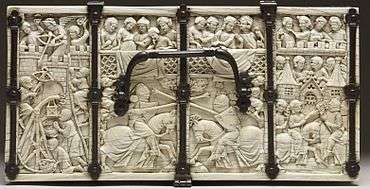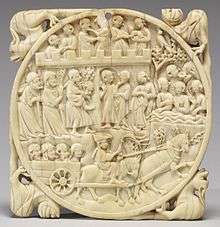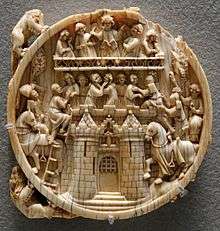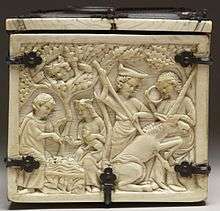Casket with Scenes of Romances (Walters 71264)


The object called by the museum Casket with Scenes of Romances (catalogued as Walters 71264) is a French Gothic ivory casket made in Paris between 1330 and 1350, and now in the Walters Art Museum, Baltimore, Maryland. The casket is 4 5/8 inches high, 9 15/16 inches wide and 5 1/16 inches deep (11.8 × 25.2 × 12.9 cm).[1]
The casket is one of the relatively few surviving Gothic ivory caskets decorated with a variety of themes from courtly literature, called composite caskets for that reason. There are at least eight known surviving examples (and numerous fragments), of which two more are also discussed in this article: firstly a casket in the British Museum with an almost identical set of scenes,[2] and one in the Cluny Museum in Paris, which shares many scenes, but diverges in others.[3]
By this period, Paris was the main European centre of ivory carving, producing large numbers of religious and secular objects, including small diptychs with religious scenes that used the same relief technique; these and smaller secular objects such as mirror-cases are more common than these caskets,[4] or larger religious statues like the Virgin and Child from the Sainte-Chapelle of the 1260s. The composite caskets differ slightly from each other, but are sufficiently similar to suggest they all originated from one Paris workshop, or group of workshops, around 1330 to 1350.[3]
This casket may well have been a gift of courtship or upon marriage, and was probably intended for an aristocratic female owner, to keep her jewels and other valuables in. The carved scenes were possibly originally painted; as the paint on Gothic ivories tended to peel in places, it was very often removed by later dealers and collectors. The unusually large size of the piece allows a wide range of the repertoire of popular scenes from different literary sources in French Gothic art to be shown, which display a variety of medieval attitudes to love and the role of women: "Themes such as lust and chastity, folly and wisdom are juxtaposed in a series of non-connected scenes".[5] Susan L. Smith has proposed that composite caskets express the power of love.[3][6] The Walters casket is first recorded in England in 1757, and was bought by Henry Walters in 1923. The iron mounts are modern, probably 19th century.[1]
Iconography
The lid shows scenes of the Castle of love and knights jousting and the sides show other scenes from French medieval romances. The themes of the lid are related to the 13th-century Romance of the Rose by Guillaume de Lorris and Jean de Meung. The Siege of the Castle of Love (or "Assault on" etc.), at the left on the lid, is a fanciful scene of courtly romance, where knights attack a castle defended by ladies and a cupid, with both sides throwing roses as missiles. This subject does not, as is sometimes claimed, appear in the Roman de la Rose,[7] and first appears in art not long before the date of the casket, as one of few secular scenes in the illuminated manuscript known as the Peterborough Psalter of 1299–1328.[8] But such a scene was staged and acted out by "many gentlemen and twelve of the fairest and gayest ladies of Padua" as part of a festival at Treviso in 1214, a century earlier.[9] In the center knights joust in front of ladies.
The scene at right has differing interpretations: either the victor, whose shield carried three roses, receives a bouquet of roses from a lady as prize,[10] or, more likely, the tournament continues, now between the ladies, fighting with flowers, and the knights using "oak branches".[11] This is the only scene on the lid that differs in the British Museum and Paris caskets, where the siege of the castle continues in the section at furthest right. A variation of this set of scenes has examples in the Cleveland Museum of Art, Detroit Institute of Arts, Château de Boulogne-sur-Mer, Walker Art Gallery and the Metropolitan Museum of Art: in the latter (17.190.173) there is an elopement scene at left, then the two central sections are the tournament, with the attack on the Castle of Love behind the elopement at left, and in the last section on the right.[12]
The front of the casket has, from the left: Aristotle teaching Alexander the Great, Phyllis riding Aristotle, watched by Alexander from a window, and at the right, old people arriving at the Fountain of Youth, and young naked people in it.[13] Phyllis riding Aristotle is the "quintessential image from the Power of Women topos", which was beginning its long career in art at this time.[14] The Fountain of Youth is a regularly occurring scene, of Eastern origin, that shows old people being carried to a miraculous spring which immediately turns them into beautiful young people,[5] one of the relatively few scenes in medieval art where figures are not just "naked" but "nude".[15] All three scenes are the same in the British Museum casket, and the Walters also has a side from a French casket of similar date but less high-quality carving, showing the first two of these scenes, but changing the last (Walters 71196, shown below). The Walters also has mirror-cases with other examples of the Siege of the Castle of Love and the Fountain of Youth.

The rear side of the casket contains scenes from Arthurian romance described in the Courtauld Institute database of Gothic ivories as: "Gawain in armour fighting the lion; Lancelot crossing the sword bridge, with spears falling from the sky; Gawain on the perilous bed; bed on wheels and with bells; lion; shield with a lion's paw; spears falling from the sky; the three maidens at the Château Merveil".[16] The sword bridge features in Lancelot, the Knight of the Cart by Chrétien de Troyes, and the perilous bed in his Perceval, the Story of the Grail. Both the Walters and British Museum caskets have the same scenes and compositions here, which both depart from the literary sources by having the rain of swords falling not only on Gawain on the bed, but also on Lancelot on the bridge, suggesting that the ivory-carver's or designer's contact with the literature was indirect.[5]
The two ends show other Arthurian scenes: the adulterous lovers Tristan and Iseult are spied upon by Iseult's husband King Mark of Cornwall, hiding in a tree; his face can be seen reflected in the pool below, which they see, enabling them to switch to innocent conversation. This end also has a scene with a wounded unicorn, a maiden and a man with holding a spear which has been run through the unicorn, in a version of the subject of The Hunt of the Unicorn where the maiden has been used to lure the unicorn to his death.[5] The other end has a scene with Galahad.
 View of the British Museum casket
View of the British Museum casket- Lid of the Paris casket

 Walters, front view
Walters, front view- Paris: a different scene at left, as a knight rescues a lady from a woodwose, and the same Galahad scene at right
- Paris: the same two Aristotle scenes (left), and two different ones to right.[18]
 Walters 71196, a different French box panel with two of the same scenes
Walters 71196, a different French box panel with two of the same scenes Walters 71170, a more common ivory mirror case with a Fountain of Youth
Walters 71170, a more common ivory mirror case with a Fountain of Youth Fountain of Youth by Lucas Cranach the Elder, 1546
Fountain of Youth by Lucas Cranach the Elder, 1546 Siege of the Castle of Love on a mirror-case in the Louvre, 1350–1370; the ladies are losing.
Siege of the Castle of Love on a mirror-case in the Louvre, 1350–1370; the ladies are losing. Master of the Housebook, Aristotle and Phyllis, 15th-century engraving
Master of the Housebook, Aristotle and Phyllis, 15th-century engraving One of the tapestry series The Hunt of the Unicorn, 1495–1505, Flanders?
One of the tapestry series The Hunt of the Unicorn, 1495–1505, Flanders?- Another Gawain on the Perilous Bed
Gothic ivories database
The Courtauld Institute maintains a database of over 5,000 Gothic ivories.[19] The database catalogues the surviving composite caskets and the known fragments as follows:
- Barber Institute of Fine Arts, Inv. 39.26
- British Museum, 1856,0623.166 (Dalton 368)
- Château de Boulogne-sur-Mer, Inv. 408 (fragment)
- Cleveland Museum of Art, 1978.39a, 1978.39b, 1978.39c (three fragments)
- Cluny Museum, Cl. 23840
- Cracow Cathedral Treasury, S/n
- Detroit Institute of Arts, 1997.6 (fragment)
- Hermitage Museum, Inv. F 2912
- Louvre, MRR77
- Metropolitan Museum of Art, 17.190.173; 1988.16, 2003.131.2 (back panel of the dismantled casket referred below)
- Victoria and Albert Museum (one example),[20][21] 146-1866, 264-1867 (no romance scenes)
- Walker Art Gallery, M 8052 (fragment)
- Walters Art Museum, 71.264
- Winnipeg Art Gallery,[22] G-73-60 (the Gort casket, discovered in a Brighton (UK) junk shop in 1945)
In addition there are fragments from a dismantled casket, known from an 18th-century engraving, whose locations are unknown, save the back panel which is in the Metropolitan Museum of Art (2003.131.2):
- Unknown location, S/n
Notes
- 1 2 Walters
- ↑ British Museum P&E 1856,0623.166, see Robinson, 216 and Ivory casket with scenes from the Romances in the Highlights on the website
- 1 2 3 Carns p.69. Both Carns and the Victoria and Albert Museum cite "eight", others "at least eight".
- ↑ Robinson, 202; Gardner's, 364; the Courtauld database records large numbers.
- 1 2 3 4 Robinson, 216
- ↑ Smith pp. 168-186. Smith focuses on one of examples in the Victoria and Albert Museum but indicates her ideas apply to the whole group.
- ↑ Loomis, 266-267
- ↑ Robinson, 216; the MS is in the Royal Library of Belgium in Brussels, as MS 9961-62, with the miniature on folio 91v.
- ↑ Loomis, 255
- ↑ So Gardner's, 364
- ↑ So the Courtauld database: "Scene 3: Mock Tournament; lady and knight on horseback; ladies jousting with stems of flowers; men jousting with oak branches; couples watching from the castle battlements; portcullis."
- ↑ See Gothic Ivories database, search on "Castle of Love"
- ↑ William and Henry Walters: The Reticent Collectors, by William R. Johnston, Walters Art Gallery, p. 208
- ↑ Russell, p. 175
- ↑ Using Kenneth Clark's famous comment in The Nude
- ↑ Courtauld
- ↑ per the entry in Courtauld database
- ↑ The scenes on the right are a medieval version of the Trial of Solomon: "Two young men argue over the inheritance of a recently deceased man; seated king; throne decorated with lions. The king orders them to shoot arrows to the shrouded corpse and only the 'false' son complies.", Courtauld database
- ↑ "Gothic ivories database". Courtauld Institute.
- ↑ "Scenes from Romance Literature". Victoria and Albert Museum.
- ↑ "Casket". Victoria and Albert Museum.
- ↑ "Casket, c. 1350". Winnipeg Art Gallery.
References
| Wikimedia Commons has media related to Casket with Scenes of Romances - Walters 71264. |
- "BM database", Entry on the British Museum database for their casket
- Carns, Paula Mae. “Compilatio in Ivory: The Composite Casket in the Metropolitan Museum”. Gesta 44.2 (2005): 69–88. JStor
- "Courtauld", The entry in the Courtauld database of Gothic ivories for the Walters casket (with bibliography etc.).
- "Gardner's", Kleiner S. Fred, Mamiya J. Christin. Gardner’s Art Through the Ages. 12th Edition. 10 Davis Drive, Belmont,CA: Joan Keyes, 2005 p. 363-4, google books
- Loomis, Roger Sherman, "The Allegorical Siege in the Art of the Middle Ages", American Journal of Archaeology, Vol. 23, No. 3 (Jul. - Sep., 1919), pp. 255–269,JSTOR (free)
- Robinson, James. Masterpieces of Medieval Art, 2008, British Museum Press, ISBN 9780714128153
- Russell, H Diane, Eva/Ave; Women in Renaissance and Baroque Prints, National Gallery of Art, Washington, 1990, ISBN 1558610391
- Smith, Susan L., The Power of Women: A Topos in Medieval Art and Literature., University of Pennsylvania Press, 1995, ISBN 978-0-8122-3279-0
- "Walters", Walters database
External links
- Virtual Model of Walters 71264, an interactive model made with Unity 3D
- The Wild Man: Medieval Myth and Symbolism, an exhibition catalog from The Metropolitan Museum of Art (fully available online as PDF), which contains material (no. 11) on casket 17.190.173 in the Metropolitan Museum of Art. This was before the original front 1988.16 was discovered and now in place. This original front differs from the formerly supplied replacement front (a fragment from a private collection) in the two right images, which are of the Pyramus and Thisbe legend rather than the Fountain of Youth described in the catalogue.
